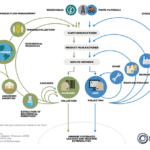
In a rapidly evolving world, where social issues demand innovative solutions, the focus on ‘social innovation’ has taken center stage. Social innovation (SI) has always existed; however, today, initiatives are multiplying as they respond to the myriad challenges society faces.
In recent years, social innovations have been garnering increasing interest from policymakers, non-governmental organizations, companies, and citizens as a viable alternative to address, or at least mitigate, social problems.
Social innovations such as microfinance, fair trade, and emissions trading have proven to be high-impact instruments for social change (Choi N. and S. Majumdar, 2015); hence, there is a desire for more innovations of this kind to emerge.
However, it’s important to note that social innovation can arise in places and from individuals outside the realm of social entrepreneurship and social enterprise; in particular, nonprofit organizations, businesses, and governments are producing social innovations (Phills et al, 2008).
This article will serve as your guide to understanding ‘social innovation.’ Whether you are new to the concept or seeking a deeper understanding, we will explore types, characteristics, projects, and real-world examples.
What Is Social Innovation (SI)?
Social innovation is a term that has gained significant momentum in recent years, but what does it really mean? To pique your interest, let’s begin with a captivating story.
Imagine a world where communities collaborate to address pressing challenges, where individuals and organizations come together to create positive social change. This is the essence of social innovation: a transformative force that transcends conventional boundaries.
According to Marques et al (2018), the concept of SI has been used since at least the second half of the 19th century under different guises and definitions.
Social innovations are new ideas that meet social needs, create social relationships, and establish new collaborations, as highlighted by the European Commission.
Regarding this, Phill et al. (2008) indicate that these innovations can be products, services, or models that address unmet needs more effectively, but they can also be a principle, an idea, a law, a social movement, an intervention, or some combination thereof.
The Stanford Business School of Business’s Center for Social Innovation defines social innovation as “the process of developing and deploying effective solutions to challenging and often systemic social and environmental issues in support of social progress.”
The same center emphasizes that social innovation is not the prerogative or privilege of any organization or legal structure and that solutions often require active collaboration among government, business, and nonprofit sectors.
Phills et al. (2008) redefine social innovation as “a novel solution to a social problem that is more effective, efficient, sustainable, or just than existing solutions and whose value is created primarily for the benefit of society as a whole rather than individuals in particular.”
Meanwhile, Choi N. and S. Majumdar (2015) state that SI is a new combination and/or configuration of social practices in certain areas of action or social contexts driven by certain actors or groups of actors intentionally aiming to better satisfy or address needs and problems than what is possible based on established practices.
In summary, the notable aspect of the definitions of social innovation is that they all agree that it is a response to the challenges faced by societies.
Social Innovator or Social Entrepreneur?
Social innovators are the driving force behind transformative change. They are individuals or organizations that challenge the status quo, coming up with innovative solutions to address social challenges.
In this regard, Audretsch et al. (2022) highlight that social innovators have the potential to address current major challenges and contribute to achieving the SDGs.
In this context, social enterprises are becoming increasingly important in addressing complex challenges through social innovation (Muhammad et al., 2022). In the same vein, Hagedoorn et al. (2023) found positive and significant relationships between the commercial and social goal orientation of social enterprises and the performance of social innovation.
On the other hand, a social entrepreneur is an individual involved in creating new businesses with social purposes, which includes a willingness to take risks and find creative solutions.
Furthermore, the European Commission uses the term ‘social enterprise’ to highlight companies whose primary goal is to have a social impact, rather than generating profits for owners and partners; they operate in the market by producing goods and services in an entrepreneurial and innovative manner.
Below, we provide a table comparing the characteristics of the social innovator and the social entrepreneur.
Table 01. Differences and Similarities between the Social Innovator and the Social Entrepreneur.
| Aspect | Social Innovator | Social Entrepreneur |
|---|---|---|
| Definition | Focuses on generating new ideas or approaches to address social issues. | Concentrates on creating and managing a business with social purposes, where financial sustainability is crucial. |
| Approach | Prioritizes innovation and creativity in seeking social solutions. | Combines innovation with entrepreneurship to achieve sustainable social change. |
| Main Objective | The primary goal is to find creative solutions to social problems. | Seeks to address social issues through sustainable business models that generate long-term impact. |
| Sustainability | May not always focus on financial sustainability and may depend on external funding. | Aims for financial sustainability through revenue generation within the social business. |
| Business Model | May not have a defined business model and may work on short-term projects. | Has a defined business model that blends profitability with social impact. |
| Impact | Can have short-term impact through projects and creative solutions. | Aims for long-term impact by addressing social issues in a sustainable and scalable way. |
| Beneficiary Focus | Focuses on developing solutions that directly benefit the community. | Considers social benefit as an integral part of its business model. |
| Examples | A designer creating an innovative system to purify water in rural areas. | A company selling eco-friendly products and allocating a portion of its profits to education projects in underserved communities. |
It’s important to note that while these differences are clear, there is often an intersection between social innovators and social entrepreneurs, as both share the goal of addressing social issues and creating positive societal change. Additionally, they may collaborate on projects that combine creative innovation with sustainable business models.
In this regard, Grilo and Moreira (2022) report that the connection between social innovation and social entrepreneurship is in its takeoff phase, but it is still a fragmented field with a lack of consensus.
Characteristics of Social Innovation
Villa and Melo (2015) published a list of characteristics that can help us identify a social innovation:
- Providing a novel and more effective, efficient, sustainable, or fair solution to a social, environmental, or cultural problem than existing solutions.
- It can take the form of a product, process, technology, regulation, intervention, or social movement.
- It can originate from any sector of society (public, private, academic, community, citizen).
- It seeks the benefit of society at large rather than that of the developer or funder of the solution.
- It is built and implemented through horizontal relationships between the solution provider and the community that receives it.
However, social innovations are also characterized by:
- Empowerment: SI empowers individuals and communities to take ownership of the issues they face. It fosters a sense of agency and self-determination.
- Adaptability: In a dynamic world, successful social innovations must be adaptable and responsive to changing circumstances. They evolve to address new challenges.
- Scalability: Scalability is crucial to achieving widespread impact. Effective social innovations can be replicated and implemented in diverse contexts.
Dimensions of Social Innovation
Choi N. and S. Majumdar (2015) report that social innovations have three dimensions:
- Content dimension: Ensures that the content or objective of SI is the satisfaction of human needs;
- Process dimension: SI includes the process of changing social relationships;
- Empowerment dimension: Increases socio-political capacity and access to resources.
Drivers of Social Innovation
The Center for Social Innovation highlights that cross-sectoral linkage underlies the three key mechanisms driving contemporary social innovation:
- Exchange of ideas and values
- Changes in roles and relationships
- Integration of private capital with public and philanthropic support.
Types of Social Innovation
Amanatidou et al., (2018) propose three types of social innovation based on the level of societal involvement:
Consulted Society
It understands SI as new ideas transferred to products, services, and business models, with a social purpose or focus. Companies are the main actors, and society or social groups are the end users of the innovations.
Society in Partnership
It defines SI as a combination and/or new configuration of social practices. It focuses on providing solutions to social problems. Key actors include the third sector working in collaboration with the public and private sectors. Society plays the role of co-creators and co-producers.
Society in Control
SI is defined as a change in social relationships to meet the needs of disadvantaged social groups. Innovations include new social practices that alter social relationships. Key actors are individuals, communities, and entire segments of society.
The Process of Social Innovation
Well, the rhetoric sounds nice, but how do we become social innovators? Below, we present the six-stage process of social innovation proposed by Murray et al. (2010).
- Suggestions, Inspirations, and Diagnoses: This stage allows diagnosing problems by identifying their causes rather than just the symptoms.
- Proposals and Ideas: Generating ideas through methods like creative thinking, user-led design, quality circles, among others.
- Prototypes and Pilots: Includes testing social innovation in practice through different prototyping methods or more informal methods.
- Sustaining: This stage is when the idea becomes a daily practice.
- Scaling and Diffusion: Involves different ways to grow and spread innovations, such as organizational growth.
- Systemic Change: Includes changes in the public sector, private sector, economy, or households.
On the other hand, Geser et al. (2019) describe the results of the European project “DOIT – Entrepreneurial skills for young social innovators in an open digital world” in developing capacities in children and young people to become social innovators. You can access the project’s toolbox here.
Also, if you’re interested in learning more about SI, you can enroll in the following free courses:
From Corporate Social Responsibility to Corporate Social Innovation by BABSON.
Examples and Projects of Social Innovation
Chile
An example of social entrepreneurship is Algramo, which is a bulk product sales system for Chile’s most vulnerable stores. The entrepreneurship aims to reduce the use of disposable packaging in purchases, with the hope of achieving a triple impact: economic, social, and sustainable.
Colombia
Colombia has a variety of social innovation programs and public policies driven by different government agencies, which have found resonance in the private sector and the social sector (Villa and Melo, 2015).
The most widely known experience of SI is Medellin’s Ruta N. While “Ruta N” is aimed at articulating the ecosystem of science, technology, and innovation to transform Medellin, a significant number of initiatives respond to social challenges.
Mexico
One of the best-known experiences is Échale, a social producer of housing and community infrastructure. To date, they have built 250,000 homes in 28 Mexican states.
European Union
The European Union has a series of projects that promote social innovations. In this regard, the Commission organizes the European Social Innovation Competition to fund projects, such as the European Union Programme for Employment and Social Innovation (EaSI). Additionally, you can access the Results Pack summarizing the results of social innovation projects carried out within the EU.
Furthermore, Gök et al. (2022) have built a database called the “European Social Innovation Database (ESID),” which gathers all social innovation projects in the European Union.
Health Sector
van Niekerk et al. (2023) describe experiences of SI in health in the Philippines, Malawi, and Colombia. They found that each of the three social innovation case studies was based on the development of community capacities to achieve health through joint learning, leadership, and community accountability. They highlight that all three creative approaches to SI improved access to and quality of health services for vulnerable rural populations and increased agency among the intervention communities.
Airbnb Disaster Response Program
Airbnb’s disaster response program connects displaced people with temporary housing during crises. This innovative approach has provided relief to countless communities affected by disasters.
Grameen Bank Microcredit Model
Founded by Nobel laureate Muhammad Yunus, Grameen Bank revolutionized access to credit for impoverished communities. This microcredit model has allowed millions of people to escape the cycle of poverty.
Social Innovation Projects
Social innovation projects are strategic initiatives designed to creatively and effectively address social and environmental issues. These projects focus on generating positive and sustainable change in our communities and worldwide.
Such projects primarily aim to: improve quality of life, reduce inequalities, and promote environmental sustainability.
Characteristics of Social Innovation Projects
Social innovation projects share several key characteristics:
- Social Impact: Their primary goal is to generate a positive impact on society and improve people’s quality of life.
- Collaboration: They foster collaboration among various stakeholders, including governments, NGOs, businesses, and the community.
- Sustainability: They seek long-term solutions that address the underlying causes of social problems.
- Creativity: They use innovative and creative approaches to find solutions to complex problems.
Conclusion
Social innovation has become a necessity in today’s world to overcome the major challenges society faces. Therefore, it is necessary to provide the right conditions for social entrepreneurs to do their work.
SI is about creativity, collaboration, and a commitment to a better world. It empowers individuals and communities to address the most pressing issues of our time.
Finally, you can also freely download a book on SI edited by UCN.
Bibliographical References
Amanatidou, E., Cox, D., & Gagliardi, D. (2018). Social engagement: towards a typology of social innovation. (MIOIR / MBS Working Paper Series – Working Paper ; Vol. 82). Manchester Institute of Innovation Research. https://doi.org/10.13140/RG.2.2.28787.84002, https://doi.org/DOI: 10.13140/RG.2.2.28787.84002
Audretsch, D.B., Eichler, G.M. & Schwarz, E.J. Emerging needs of social innovators and social innovation ecosystems. Int Entrep Manag J 18, 217–254 (2022). https://doi.org/10.1007/s11365-021-00789-9
Choi N. and S. Majumdar. 2015. Chapter 2: Social Innovation: Towards a Conceptualisation. In: Satyajit Majumdar, Samapti Guha and Nadiya Marakkath (Eds.) Technology and Innovation for Social Change. DOI 10.1007/978-81-322-2071-8
Geser G., E. Hollauf, V. Hornung, S. Schön, F. Vloet. 2019. Makerspaces as Social Innovation and Entrepreneurship Learning Environments: The DOIT Learning Program. Discourse and Communication for Sustainable Education, vol. 10, no. 2, pp. 60ñ71, 2019. DOI: 10.2478/dcse-2019-0018
Gök, A., Antai, R., Milošević, N. et al. Building the European Social Innovation Database with Natural Language Processing and Machine Learning. Sci Data 9, 697 (2022). https://doi.org/10.1038/s41597-022-01818-0
Grilo, R., & Moreira, A. C. (2022). The social as the heart of social innovation and social entrepreneurship: An emerging area or an old crossroads? International journal of innovation studies, 6(2), 53-66.
Hagedoorn, J., Haugh, H., Robson, P. et al. Social innovation, goal orientation, and openness: insights from social enterprise hybrids. Small Bus Econ 60, 173–198 (2023). https://doi.org/10.1007/s11187-022-00643-4
Marques, Pedro, Morgan, Kevin and Richardson, Ranald 2018. Social innovation in question: The theoretical and practical implications of a contested concept. Environment and Planning C: Politics and Space 36 (3) , pp. 496-512. 10.1177/2399654417717986
Muhammad Ashraf Fauzi, Puteri Fadzline Muhamad Tamyez & Senthil Kumar (2022) Social Entrepreneurship and Social Innovation in ASEAN: Past, Present, and Future Trends, Journal of Social Entrepreneurship, DOI: 10.1080/19420676.2022.2143870
Murray R, Caulier-Grice J, Mulgan G (2010) The open book of social innovation.
Phills J., K. Deiglmeier & D. Miller. 2008. Rediscovering Social Innovation. Stanford Social Innovation Review.
van Niekerk, L., Bautista-Gomez, M.M., Msiska, B.K. et al. Social innovation in health: strengthening Community Systems for Universal Health Coverage in rural areas. BMC Public Health 23, 55 (2023). https://doi.org/10.1186/s12889-022-14451-8
Villa L. y J. Melo. 2015. Panorama actual de la innovación social en Colombia. Banco Interamericano de Desarrollo (BID). 84 p.





